St. Luke's and Patient Access: 'moving toward better'

Access to care is a national challenge, and certainly is an issue in Idaho.
We, like many areas of the country, do not have enough physicians in all the specialties needed to fully meet the needs of the population we serve. In addition, there is inequity in access to care in rural parts of the state vs. urban areas and for those without insurance vs. those that are insured.
St. Luke’s realizes that access to care is a problem and it has shown up on our community health needs assessments. We are trying to do something about it. St. Luke’s understands that improving access improves health outcomes and can lower healthcare costs by averting high-cost complications from developing and by providing the appropriate care in the lowest appropriate cost environment.
Here Roya Camp, my blog editor, reports on the efforts being made at St. Luke’s to improve access.
“St. Luke’s Health System will transform health care by aligning with physicians and other providers to deliver integrated, seamless, and patient-centered quality care across all St. Luke’s settings.”
 That’s our vision statement and what we aspire to. But just how much effort is going into making it happen, on all fronts, every day, is hard to imagine – unless you’ve got a ringside seat to the action.
That’s our vision statement and what we aspire to. But just how much effort is going into making it happen, on all fronts, every day, is hard to imagine – unless you’ve got a ringside seat to the action.
That seat recently was in a crowded meeting room at a St. Luke’s location in Boise, where dozens of nurses, physicians, medical assistants, and support staff members gathered to work through the bottlenecks and pain points that patients might experience calling or connecting with our organization.
For some time, St. Luke’s Physician Services and Patient Access departments have been focusing on making it easier for people to get the information and appointments they want, follow up on questions about medications, and take care of other healthcare needs. The collaboration has resulted in expanded nurse triage services after regular clinic hours, streamlined provider referral processing, and improved timeliness of insurance authorization for diagnostic procedures.
“We know that if we are going to transform our delivery system to meet the needs of our patients during their first call or contact, the first step is to understand this experience and work as a team to improve processes in alignment with our vision,” said Mary Cronin, senior director of operations for Patient Access Services.
Dr. Terry Ribbens, St. Luke’s Clinic division medical director for family medicine in the West Region, said that over time, layers of process and paper-shuffling have cut into physicians’ time with patients, and that to solve that problem is to improve the delivery of health care at an expanded level. That’s why he started splitting his time between practice and administration about a year ago and has jumped into the process improvement work.
“In order to be able to do population health and to meet the needs of the future, we need a different approach,” Dr. Ribbens said. “The goal is to utilize everyone at the top of their license to do things for the patient that the provider doesn’t have to do. And to understand and accomplish that, you have to break all the work flows down.
“Today, it’s not perfect, but we’re moving toward better,” he said. “It’s still about patient care, and about trying to mold the (electronic health records) tool to help physicians deliver patient care. I get excited about that.”
 The ways people connect with St. Luke’s – the clinics, the phone, electronic health records, the Internet – continue to become more varied and diverse, and shifting the clinical model, which is part of St. Luke’s strategy, has meant learning from others, a willingness to approach our challenges differently, and a firm foundation in St. Luke’s lean-based TEAMwork management operating system to evaluate and re-design the processes.
The ways people connect with St. Luke’s – the clinics, the phone, electronic health records, the Internet – continue to become more varied and diverse, and shifting the clinical model, which is part of St. Luke’s strategy, has meant learning from others, a willingness to approach our challenges differently, and a firm foundation in St. Luke’s lean-based TEAMwork management operating system to evaluate and re-design the processes.
Sandy Stevenson, St. Luke’s senior director of primary care, was the director of family medicine within Physician Services several years ago when several St. Luke’s clinics piloted electronic health records. It was an admittedly tough transition for clinicians and patients alike, and a visiting physician suggested a trip to the University of Utah.
“It was ‘How do we become more efficient?’” Stevenson recalled.
St. Luke’s representatives saw what the university was doing with centralized functions that left clinicians free to focus on face-to-face care. Others from St. Luke’s witnessed the same thing at a health system in Chicago, and a trip to Seattle cemented ideas and an approach. It was clear that work could be centralized, standardized, and greatly improved. Over time, additional St. Luke’s physicians visited the other systems and became convinced that changes might support their work and interactions with patients.
The recent “Ambulatory Work Flow Redesign Week” – it was closer to 10 days – is only one aspect of an ongoing, end-to-end improvement process. In many respects, it’s the scale of the effort that has been the biggest challenge.
“It is just a complex amount of work,” Stevenson said. “We’re trying to redesign work that can be replicated across all the clinics.
“And some of them are coming off of paper charts.”
By dedicating two weeks, and dozens of clinicians and others, to the goal of an exceptional, patient-centered experience, St. Luke’s has been able to see what patients see, and to start building better approaches.
The work group walked through clinic scheduling processes and dozens of variations on those functions to identify where calls get dropped, where information might go astray, and where patients might unnecessarily need to repeat conversations, tests, or other components of their experience with St. Luke’s.
Walls of the meeting room were plastered with color-coded sticky notes showing points in the processes that staff members had identified as challenging or worthy of attention. By the end of the two-week focus period, the team had outlined 12 main work streams and identified hundreds of areas for further discussion and action.
Results from earlier efforts to standardize patient rooming processes across the dozens of clinics convinced the team that they needed to work upstream on the workflow functions to be more effective in the clinic settings. It’s an ongoing effort, but has convinced organizers that it’s the right thing to do and will result in big efficiencies down the line.
“Watching the synergy that resulted from getting the right people together, all with different perspectives, with a common purpose to improve the patient experience was one of my proudest moments at St. Luke’s,” Cronin said. “I am a patient. My family and friends are patients. This work is important, and to see our team believe in the endless possibilities of ‘better’ was beyond what I had envisioned.”
That synergy empowers physicians, all members of the team – and ultimately, patients, Dr. Ribbens believes, adding that he thinks St. Luke’s approach to improving the patient experience is somewhat unique when it comes to the level of staff and physician engagement.
“It was wonderful to have all the perspectives,” he said. “I welcome that input.
“I think that providers who do not embrace the evolution of the healthcare team are going to struggle moving forward,” Dr. Ribbens said. “I can’t take care of patients well without a good supporting staff. I think that’s where the future of medicine is.”
Is the team done?
Not at all and in fact, the work is just beginning. Another wave of St. Luke’s staff members will step through a similar process with a focus on what St. Luke’s patients experience in primary care clinics.
“We have only begun,” Cronin said. “I believe in our mission, and I believe we have taken a few important steps forward.
“I’m excited for the future and the possibilities.”
About The Author

David C. Pate, M.D., J.D., previously served as president and CEO of St. Luke's Health System, based in Boise, Idaho. Dr. Pate joined the System in 2009 and retired in 2020. He received his medical degree from Baylor College of Medicine in Houston and his law degree from the University of Houston Law Center.

